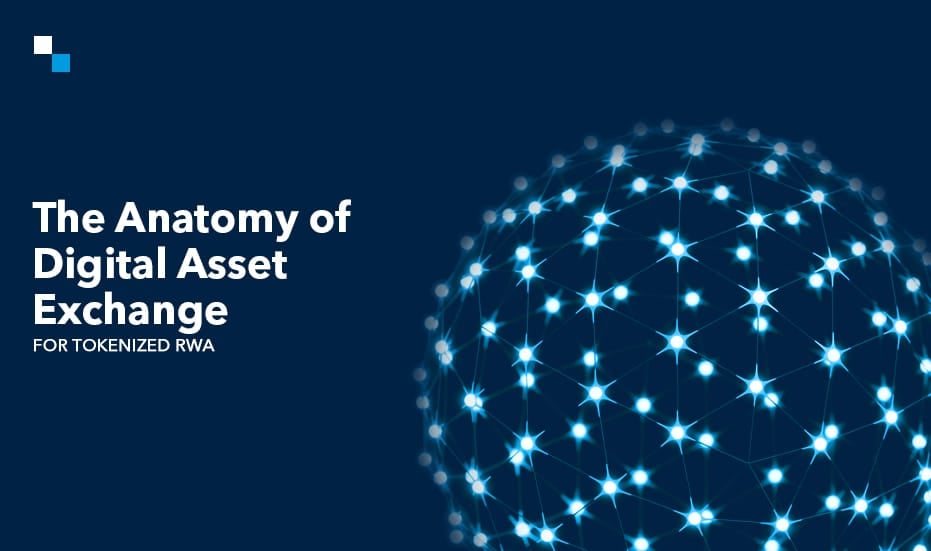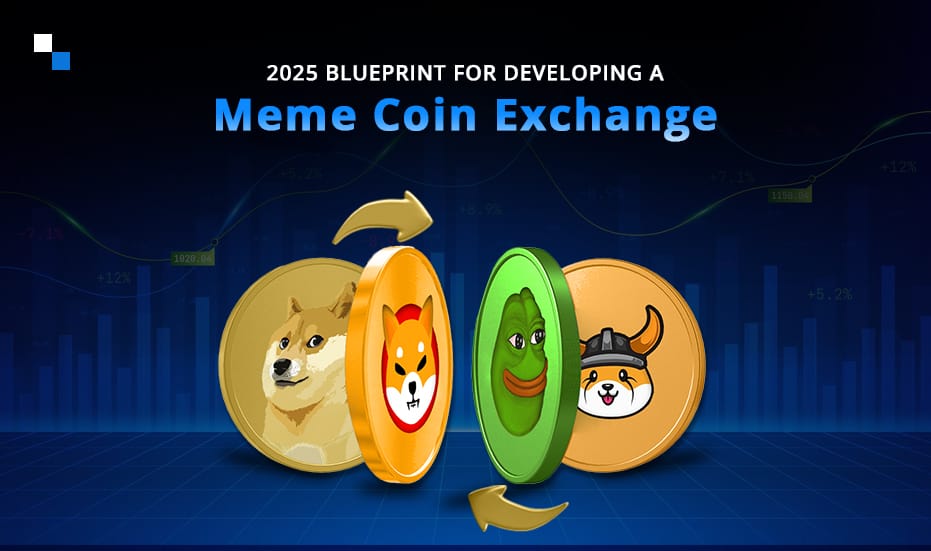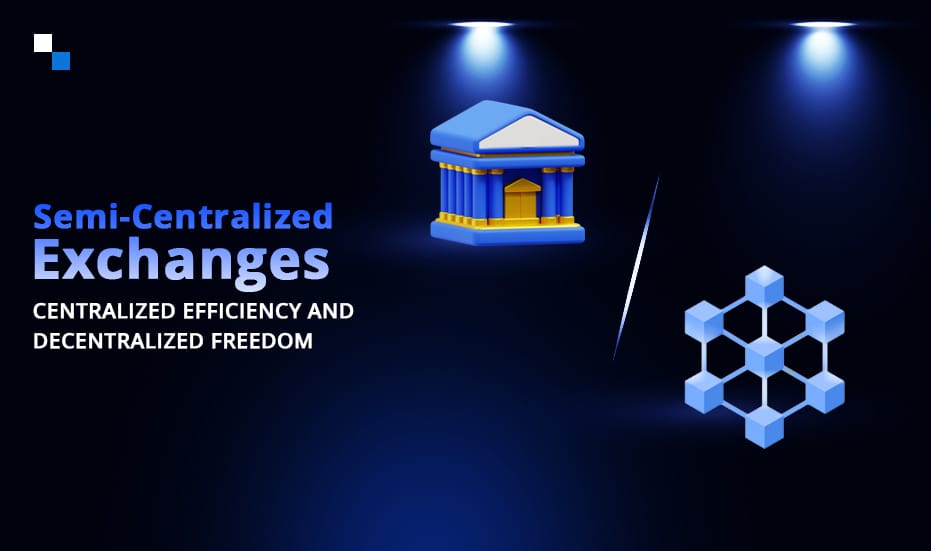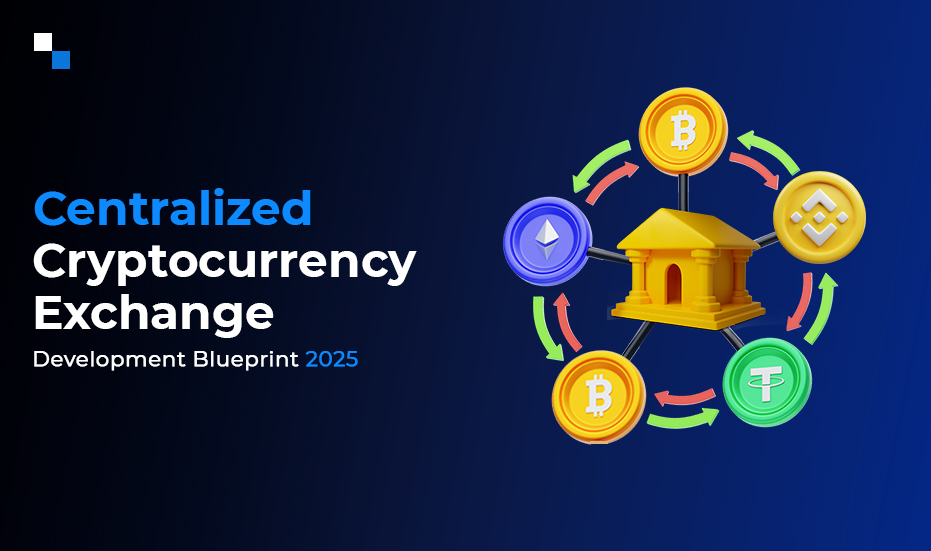
Top 10 White-Label Wallet App Trends to Explore in 2025
October 29, 2024
The 15-Day GameJam: Build a Game Like Catizen from Scratch
November 5, 2024A massive chunk of the world’s wealth lies trapped in illiquid assets. Illiquid assets usually trade at discounts and suffer from lower trading volumes and poor price discovery mechanisms. Real-world asset tokenization turns the tide by introducing enhanced liquidity, better price discovery, fractional ownership, and global accessibility. BCG predicts the total illiquid asset tokenization size will reach $16 trillion by 2030.
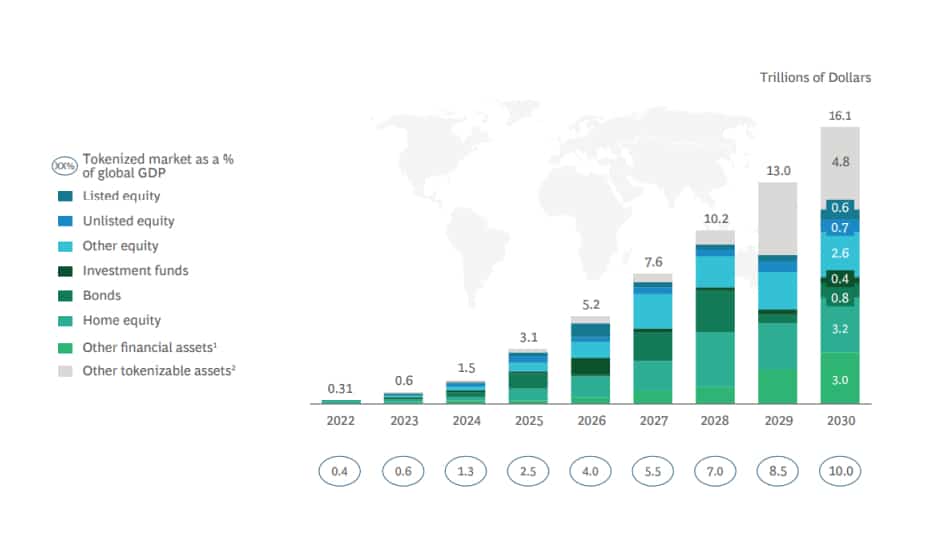
The report also mentions a forecast, demonstrating a tokenization potential of $68 trillion by 2030 in the best-case scenario.
Given the immense potential, digital asset exchange for tokenized RWAs is emerging as a goldmine business opportunity. Tokenized RWAs represent real-world assets such as real estate properties, art, collectibles, intellectual properties, or commodities on a blockchain. By building digital exchange platforms that allow trading and investment in these assets, businesses can tap into the burgeoning RWA tokenization market.
Let’s further explore:
The RWA Market Potential
A study by Chainlink shows that the global RWA market stands at $867 trillion and only 0.001346% of the value exists on-chain. So, we definitely have huge untapped potential. The RWA growth narrative is so popular and hot that we have varying projections for 2030 based on a wide range of perspectives.
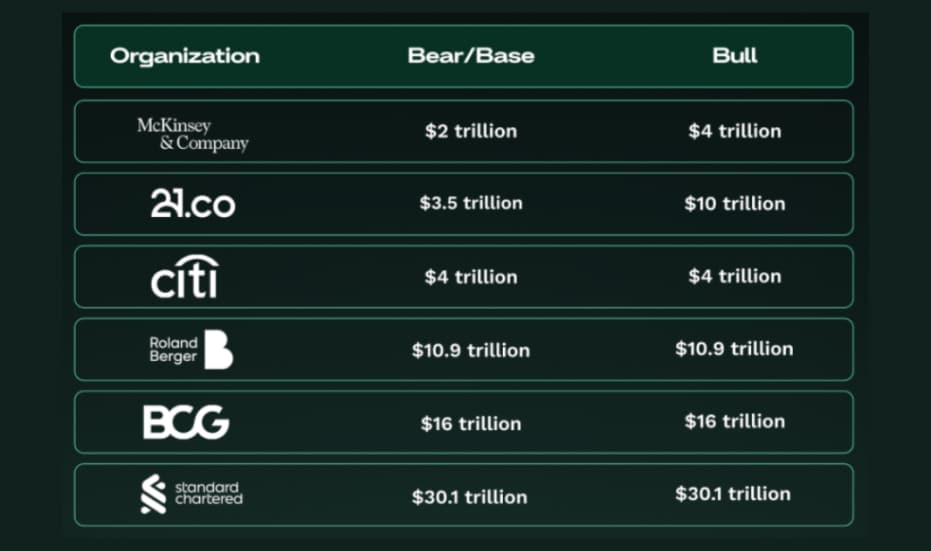
After looking at these conservative and optimistic RWA valuation forecasts from renowned analytics experts, one can clearly determine the profitability of setting up a digital asset exchange platform for tokenized RWA. Tren Finance also published research currently stating the value of on-chain assets at $187 billion. The industries exploring on-chain tokenization and their estimated on-chain value include:
- Stablecoins: $170 billion
- Private Credit: $9 billion
- Real Estate: $3.8 billion
- Securities and Treasuries: $2.2 billion
- Commodities: $1 billion
- ReFi: $150 million
- Collectibles: $60 million
- Intellectual Property: $50 million
- Others: $130+ million
Need more reasons to set up a digital asset trading exchange for tokenized RWA? Here they are.
5 Reasons Why You Should Invest in RWA Digital Asset Exchange Platform
- Unlocking Liquidity for Traditionally Illiquid Assets
Tokenizing real-world assets like real estate, fine art, or private equity allows fractional ownership, making it easier for investors to buy and sell smaller shares of high-value assets through digital asset exchange platforms. This unlocks liquidity in traditionally illiquid markets, attracting a wider range of investors and potentially increasing trading volume on your platform.
- Early Bird Advantage
As more assets are tokenized, the demand for a robust infrastructure facilitating their trading is expected to grow. Instituting a digital exchange platform for tokenized RWAs positions you at the forefront of this expanding market, allowing you to attract early adopters and grow with the industry. With an innovative, blockchain-driven solution, you can also establish your brand as a leader in an emerging, prosperous market.
- Democratizing RWA Ownership
Conventionally, these high-value illiquid assets remain within the reach of elite income groups. By setting up a digital asset exchange platform for tokenized RWA, you can facilitate fractional ownership of such assets. By breaking down assets into smaller, more affordable tokens, you open up investment opportunities to a wider pool of investors, including retail and international investors. Tokenization breaks geographical and financial shackles, enhancing the accessibility of asset classes that were once reserved for institutional investors or high-net-worth individuals.
- Enhanced Traceability and Security
By building a digital asset trading exchange specifically for tokenized RWA, businesses can offer a unique value proposition as blockchain technology enables transparent, immutable records of ownership, transactions, and asset provenance. This builds trust with investors who value security and traceability. Additionally, automated smart contracts reduce reliance on intermediaries, make processes paperless, and minimize errors, ensuring accurate, timely, and secure transactions.
- Diversifies Revenue Streams
An RWA digital exchange platform offers multiple revenue streams, from transaction and listing fees to premium services such as asset valuation, auditing, and compliance support. These diversified income sources boost your business profitability and make it more resilient to market fluctuations, providing a solid foundation for long-term success.
Key Components of a Tokenized RWA Digital Exchange Platform

Building a digital asset trading exchange for tokenized RWAs involves setting up a primary and secondary marketplace.
Let’s explore the key components of a tokenized RWA digital exchange platform:
1. Asset Tokenization Mechanism:
This module of your digital asset exchange converts physical assets into digital tokens on a blockchain. A secure and compliant mechanism issues these tokens, which are globally accessible and available for fractional ownership.
Key Features:
- Smart contract-based token issuance.
- Compliance with asset-backed security standards.
- Transferability and fractional ownership.
2. Blockchain Infrastructure:
The distributed ledger technology forms the robust foundation supporting the exchange’s decentralized operation. Choosing a reliable blockchain that supports smart contracts and tokenization (like Ethereum, Polygon, or any specialized one) for digital asset exchange platform development is essential for maintaining transparency, security, and efficiency.
Key Features:
- Public or private blockchain integration.
- High transaction throughput for efficient trading.
- Scalability and support for decentralized applications (dApps).
3. Smart Contract Development:
Smart contracts govern the issuance and trade of tokenized assets. They automate transactions, ownership transfers, and other functions on the tokenized RWA digital exchange platform. The immutable nature of these self-executing programs ensures that ownership is securely transferred between buyers and sellers as per the preset rules without the involvement of intermediaries.
Key Features:
- Self-executing contracts for transactions.
- Built-in compliance and regulatory checks.
- Automated dividend distribution for income-generating assets like real estate.
4. Regulatory Compliance Module
Adherence to legal and regulatory standards is essential for facilitating tokenized RWA trading, especially in jurisdictions with stringent financial regulations. The digital asset exchange platform must comply with KYC (Know Your Customer), AML (Anti-Money Laundering), and asset classification laws.
Key Features:
- KYC/AML verification processes.
- Jurisdiction-based regulatory adherence.
- Auditable transactions for regulators.
5. Custody Solutions
Custody solutions ensure the secure storage of both digital tokens and any associated legal documentation. Custodians may also ensure the asset’s integrity and security. The tokenized RWA digital exchange platform owners may also build non-custodial wallets for a more decentralized and secure storage provision.
Key Features:
- Cold storage for digital tokens.
- Safekeeping of legal documents linked to the tokenized assets.
- Third-party custodians for added security.
6. Liquidity Management
Liquidity is crucial for digital asset trading exchanges built for tokenized RWAs, as illiquid markets discourage trading activity. Optimized liquidity ensures that traders can easily buy and sell tokenized assets. To enhance liquidity, exchanges can partner with external liquidity providers or establish internal liquidity pools.
Key Features:
- Liquidity pools for instant trades.
- Integration with external liquidity providers.
- Market-making tools to ensure price stability.
7. Market Data and Analytics Tools
Access to accurate and real-time market data is vital for traders making informed decisions on digital asset exchange platforms built for tokenized RWAs. These tools provide users with insights into asset performance and market trends.
Key Features:
- Real-time price feeds and sentimental analysis.
- Historical data analysis tools
- Tools for asset performance comparison and analytics.
8. UI/UX
A clean, intuitive, and responsive interface is imperative for offering a seamless experience for users on the tokenized RWA digital exchange platform and encouraging user adoption. The platform should enable effortless access to trading, asset management, and user account functionalities.
Key Features:
- Responsive and mobile-friendly design.
- Customizable dashboards for tracking investments.
- Easy onboarding and navigation.

9. Payment Gateways and Fiat Onramps
Integrating a diverse set of payment options, including fiat gateways, within your digital asset trading platform is essential to providing seamless access for both traditional and crypto-savvy investors. Enabling users to buy tokenized assets with fiat currencies increases accessibility and therefore broadens your user base.
Key Features:
- Fiat onramps for traditional investors.
- Crypto payment gateways for digital-native users.
- Support for multiple payment methods (credit/debit cards, Apple Pay, UPI and bank transfers, etc.).
10. Security Protocols
Protecting the users from cyberattacks and unauthorized access is paramount for any digital asset exchange, especially when dealing with high-value tokenized RWAs. Coordinate with your cryptocurrency exchange development company to include state-of-the-art security mechanisms.
Key Features:
- Multi-signature wallets for asset security.
- End-to-end encryption for data protection.
- Multi-factor authentication
- Regular audits and security testing.
11. Dispute Resolution and Governance Mechanisms
The decentralized nature of blockchain may lead to disputes in ownership or transactions. A built-in governance structure can help settle such disputes fairly. Additionally, governance tokens or voting systems can allow stakeholders to participate in digital exchange platform decisions.
Key Features:
- Automated dispute resolution via smart contracts.
- Voting mechanisms for governance.
- Support for arbitration in cases of complex disputes.
12. Integration with DeFi
Integrating DeFi functionalities allows users to leverage their tokenized assets for additional financial activities such as collateralized loans, lending, staking for rewards, or participation in yield farming protocols.
Key Features:
- Staking options for tokenized assets.
- Integration with lending and borrowing platforms.
- Yield generation mechanisms
Conclusion:
The future of finance is undoubtedly intertwined with the digital revolution. RWAs represent a significant step forward, offering unprecedented opportunities for investment and liquidity.
In the beginning of the post, we have explicitly elaborated on why the tokenized RWA digital exchange platforms will be all the rage in the future. The paradigm shift is time-consuming due to regulatory, liquidity, transparency, technological, and operational hurdles.
By leveraging the power of blockchain technology and partnering with a seasoned RWA tokenization and cryptocurrency exchange development company like Antier, you can navigate the complexities of this emerging market and position yourself as a pioneer in the industry.
Hop on a call with us and let our experts take you through some of our best implementations in the RWA and crypto exchange space.
